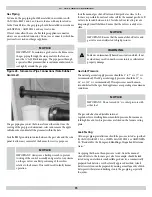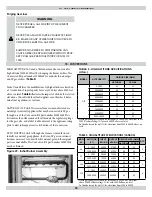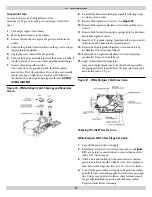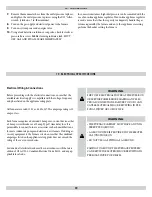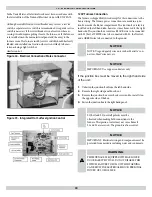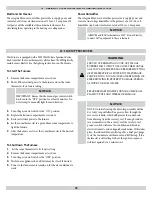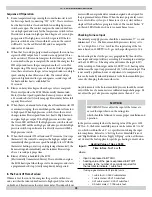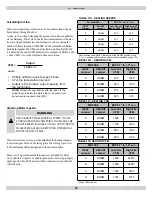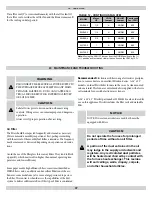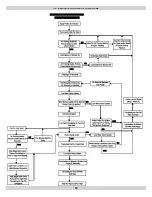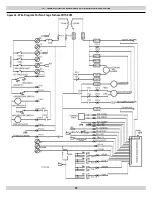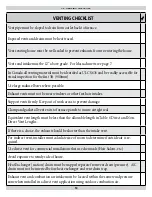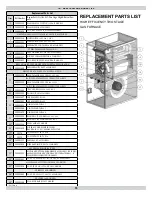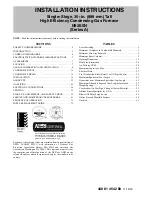
!
WARNING
HOLES IN THE EXHAUST PIPING OR FURNACE
HEAT EXCHANGER CAN ALLOW TOXIC FUMES TO
ENTER THE HOME AND CIRCULATE THROUGH
THE DUCT SYSTEM RESULTING IN CARBON MON-
OXIDE POISONING OR DEATH. IF LEAKS ARE
FOUND IN THE FURNACE HEAT EXCHANGER, IT
MUST BE REPLACED.
Operating Tips
1.
Clean air fi lters maximize effi ciency and reduce heating costs.
2.
During the heating season, keep windows and doors closed to
reduce the heating load on the system.
3.
Avoid excessive use of kitchen exhaust hoods and other exhaust
fans to reduce the heating load on the system.
4.
Arrange the furniture and drapes so that the supply air registers
and return air grilles are unobstructed.
5.
If you have a perimeter duct system, ideally, the warm air
should bathe the cold exterior walls. Avoid the use of plastic
defl ectors on the supply air registers which tend to short circuit
the warm air straight into the return air grilles. Th
ese defl ectors
are oft en the cause of cool draughts across the fl oor.
6.
Avoid placing heat producing appliances such as televisions,
radios, lamps, etc. in a location to infl uence the thermostat.
7.
Keep combustible articles at least 3 feet away from the furnace.
Do not block access for servicing the furnace Do not use the
combustion air or exhaust piping as a hanger for clothes or
anything else.
NOTICE
IMPORTANT: Never attempt to operate the furnace with-
out the blower door and combustion compartment door in
place or when the blower has failed.
Annual Inspection/Service
Th
e furnace must be inspected annually by a qualifi ed installation
contractor, service agency or fuel supplier. Your annual inspection
will normally cover the following:
HEAT EXCHANGER
- Th
e heat exchanger should be inspected for
corrosion. Th
e fl ue passages (heat exchanger tubes) should be free of
scale or excessive corrosion. Th
e top row of heat exchanger tubing
is accessible for cleaning with a small diameter wire-handled brush
24 - MAINTENANCE AND TROUBLESHOOTING
Lubrication
Both the induced draft blower motor and circulating fan motor are
ball-bearing type motors. Neither requires routine lubrication.
NOTICE
IMPORTANT: Th
e motor bearings were pre-lubricated
by the motor manufacturer. Do not attempt to lubricate
them. Excess lubrication will void the warranty, shorten
the service life if the motors, and will attract the buildup of
dust and dirt.
Th
e induced blower motor and circulating fan motor must be
cleaned on a periodic basis by a qualifi ed service technician. Dust
buildup in the ventilation ports of the motor will cause the motor to
not dissipate heat properly resulting in reduced service life.
Terminations
Th
e combustion air and exhaust terminals should be inspected oc-
casionally to ensure that they are free of obstructions and debris.
If screens were used in either terminal, ensure that they are free of
debris, corrosion, or anything preventing the free fl ow of air. In
weather conditions when snow build-up occurs, the homeowner
should inspect the vent terminal and air intake regularly to ensure
they are free and clear of snow. Maintain at least one foot of clear-
ance between snow build-up and vent/combustion air intake open-
ings at all times. Clear away excess snow to maintain this clearance.
Figure 37 - Vent Terminal Clearance
Intake Air/Exhaust Piping
Th
e combustion air intake piping and exhaust piping should be
inspected periodically for sags, evidence of leakage etc. If either
condition exists, contact your installation contractor, service agency
or fuel supplier.
48


